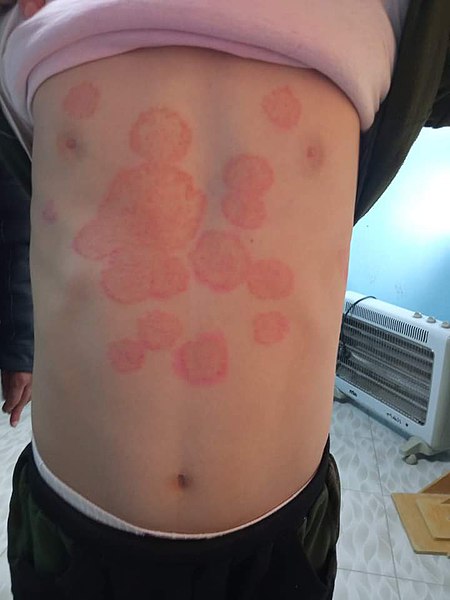Playlist
Show Playlist
Hide Playlist
Dermatophytes – Subcutaneous, Cutaneous and Superficial Mycoses
-
Slides 09 SubcutaneousCutaneous MicrobiologyAdvanced.pdf
-
Download Lecture Overview
00:01 The next fungus I’d like to tell you about is collectively called the Dermatophytes. 00:07 Infections with dermatophytes are the most common fungal infections of humans; almost everyone has these at one time or another. This infection on the skin is often called ringworm or tinea and that's because the lesions get bigger and bigger in a serpentine manner, so they are originally called ringworm, but no worm is involved. It's a fungus. It's a dermatophyte and in fact it's better to use the Latin name 'tinea'. Tinea means 'worm', but most people don't know that and so it sounds more medically important. And there are a number of places where dermatophytes can cause their typical lesions on your body. 00:52 Depending on where they are, they have different names. So for example if the infection is on your head it's called Tinea capitis, if the infection is on your feet, it's called Tinea pedis, if the infection is on your body or anywhere else it's called Tinea corporis, if it’s in your crotch it's called Tinea cruris, if it is in your nails, in the actual substance of your finger or toenails, it's called Tinea unguium or onychomycosis. There are street names for all of these afflictions. Of course when it's on your feet, it's called athlete's foot, when it's in your crotch, it's called jock itch or jungle rot, very colorful names for these afflictions. By the way, the athlete's foot, you pick up by walking in a locker room, because other people have this affliction. Members of three different genera of fungi, dermatophytes of course, can cause these infections at different parts of the body. Microsporum, and these are very unusual structures, we haven't seen anything like this before, Trichophyton and Epidermophyton. So all of these are found environmentally and they all can cause dermatophyteses. These are not members of our normal flora, so many of the fungi we've talked about in these lectures are not members of the normal flora, a few are. But most of them are environmentally acquired and the same goes for the dermatophytes. 02:29 Where do you find these dermatophytes? Well some grow in the soil as you might expect, others are found in animals. Your pets may have them, your pet dog or your pet cat, and others you acquire from another human, who in turn acquired it from the soil or from an animal as well. And when you acquire it from another human, typically close contact is needed or you may pick it up off the locker room floor, as I said, where it was left by another human before you. These fungi survive on wet surfaces, the walls of showers, the floors of locker rooms, and this is how they're transmitted. You know when you think about it, the locker room is not a very clean place, lots and lots of people go there. I’m talking about locker rooms in school gyms and health clubs that you may go to, the floor can be covered with spores from these fungi, you are likely to pick up athletes foot there, that's why they call it athlete's foot, because you typically pick it up in a locker room. 03:28 You should wear flip-flops when you walk around the locker room, because that's not the only infection you can pick up, you can also get warts. People have lots of warts on the bottom of their feet and those are caused by viruses, the papilloma viruses. So you can get warts, you can get athlete's foot, please wear flip-flops. You know what those are right? Those plastic things that fit between your feet, you can even take a shower in them, you never have to take them off until you're ready to get dressed and then put a towel on the floor. I know I am giving you too much advice, but really you don’t want to get these infections. 04:01 Dermatophytoses, you have to have a break in the skin to get these infections. You can get a cut on your arm or hands, even the athlete's foot, usually you have an abrasion on the bottom of your foot which is not hard to get, a little micro abrasions are sufficient, not a cut as shown in this picture. The fungus then spreads through the stratum corneum, stratum coreum does not invade the dermis, very rarely. So these are superficial mycoses, and you get these rings shapes when they are present on your body, and that's because the organism spreads. It grows outward and you have this ring formation, and again, people thought this was a worm so they called it tinea. Dermatophytes can also invade your fingernails or toenails or hair shafts, so that's how you would get these infections, right in the nail of your finger. Most of these can be treated with topical antifungal creams, but if you have one of these dermatophytosis in your fingernails, a topical antifungal will not take care of it. You have to take systemic drugs. You have to take antifungal agents by mouth, and they will spread throughout your body and get into your fingernails or toenails eventually, and this you have to do for three or four months. The very angry lesions that you see, these circular lesions, redness, these are a consequence of our inflammatory reaction to fungal antigen, so that's our immune system reacting to their presence there. 05:33 The products of the immune system are often effective, but not often pretty and they do cause the redness which is the cardinal feature of these dermatophytosis, and again as I said you can treat most of them with topical antifungal creams and lotions such as tolnaftate, allylamines and azoles. Just go to your local drugstore, there is probably a whole aisle for athlete's foot and other infections such as this.
About the Lecture
The lecture Dermatophytes – Subcutaneous, Cutaneous and Superficial Mycoses by Vincent Racaniello, PhD is from the course Fungi.
Included Quiz Questions
Which of the following terms refers to the ringworm infection of the scalp?
- Tinea capitis
- Treponema pallidum
- Sporothrix schenckii
- Tinea cruris
- Ascaris lumbricoides
What are the names of the three genera of dermatophytes that cause infection?
- Microsporum, Trichophyton, Epidermophyton
- Microsporum, Blastomyces, Trichophyton
- Blastomyces, Trichophyton, Candida albicans
- Sporothrix schenckii, Blastomyces, Trichophyton
- Trichophyton, Candida albicans, Blastomyces
What is the most appropriate treatment for a dermatophyte infection of the toenails that has failed topical therapy?
- Switching to systemic antifungal drugs
- Changing to antibiotics instead of antifungal drugs
- Changing to antiviral instead of antifungal drugs
- Increasing the dosage of topical antifungal drugs
- Changing to a different topical antifungal drug
Which of the following mechanisms is responsible for the clinical manifestations of athlete's foot?
- Inflammatory response to fungal antigens
- Destruction of blood vessels
- Release of excessive epinephrine, which constricts peripheral blood vessels
- Release of aldosterone, which increases blood pressure
- Release of erythropoietin, which increases RBC production
Customer reviews
5,0 of 5 stars
| 5 Stars |
|
5 |
| 4 Stars |
|
0 |
| 3 Stars |
|
0 |
| 2 Stars |
|
0 |
| 1 Star |
|
0 |





